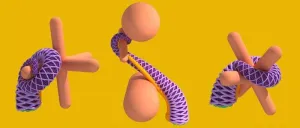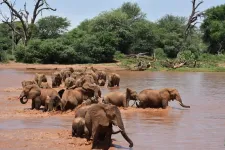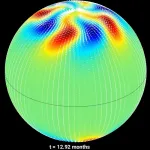(Press-News.org) Surfers could be protected from future shark attacks following new discoveries about how to trick sharks’ visual systems made by Professor Nathan Hart, head of Macquarie University’s Neurobiology Lab, Dr Laura Ryan and colleagues.
Hart, Ryan and their co-authors of a new paper in Current Biology titled Counterillumination reduces bites by Great White Sharks say their work “may form the basis of new non-invasive shark deterrent technology to protect human life”.
These researchers previously discovered that great whites place a high reliance on their eyes to locate prey, lunge upwards to take potential food such as a seal in their jaws.
In related studies, researchers have found that great whites are likely completely colour blind with poor visual acuity, compensated by their strong ability to detect a silhouette. But the shark’s poor vision means they can’t distinguish the silhouette of a surfboard or a human in the water from a seal, leading great whites to pose a danger to people.
The researchers took inspiration from juvenile plainfin midshipman fish which have photospores on its underside that produce light and disrupt the shape of its silhouette.
They trialled a method to disguise silhouettes on the water surface using lights so that the shark would not see them as food.
To test this out this counterillumination strategy Dr Ryan took multiple trips over six years, in notorious great white shark hot spot, Mossel Bay in South Africa.
The researchers towed 1.2m long, seal-shaped foam decoys on a 20m line behind a boat to attract sharks to attack. Then they used LED lights, in different configurations, to break up the silhouette of the decoys. They found lights placed in stripes across the bodies of the seal decoys perpendicular to their movement were an effective deterrent.
“It’s sort of like an invisibility cloak but with the exception that we are splitting the object, the visual silhouette, into smaller bits,” says Professor Hart. “It’s a complex interaction with the shark’s behaviour. The lights have to be a certain pattern, a certain brightness.”
By Tim Dodd, Macquarie University Lighthouse
END
Could lights stop shark attacks
New study in Current Biology
2024-11-11
ELSE PRESS RELEASES FROM THIS DATE:
Alarming increase in alcohol use during pandemic persists
2024-11-11
Embargoed for release until 5:00 p.m. ET on Monday 11 November 2024
@Annalsofim
Below please find summaries of new articles that will be published in the next issue of Annals of Internal Medicine. The summaries are not intended to substitute for the full articles as a source of information. This information is under strict embargo and by taking it into possession, media representatives are committing to the terms of the embargo not only on ...
Pandemic-era increase in alcohol use persists
2024-11-11
LOS ANGELES — Alcohol use increased during the COVID-19 pandemic and remained elevated even after the pandemic ended, according to a large nationally representative Keck Medicine of USC study published today in the Annals of Internal Medicine.
From pre-pandemic (2018) to the height of the pandemic (2020), heavy alcohol use among Americans rose by 20%, and any alcohol use rose by 4%. In 2022, the increases were sustained.
The rise in drinking was seen across all age groups, genders, race, ethnicities and regions of the country, except for Native Americans and Asian Americans. Adults ...
A new milestone in the study of octopus arms
2024-11-11
Mechanical engineering PhD candidate Arman Tekinalp, fellow graduate student Seung Hyun Kim, Professor Prashant Mehta, and Associate Professor Mattia Gazzola, all from the Department of Mechanical Science and Engineering at the University of Illinois Urbana-Champaign, recently published in the Proceedings of the National Academy of Science (PNAS). Their interdisciplinary collaboration also included Assistant Professor Noel Naughton (formerly a Beckman fellow) from the Department of Mechanical Engineering at Virginia Tech alongside researchers from the Department of Molecular and Integrative Physiology at Illinois ...
Fighting microplastics for a cleaner future
2024-11-11
Microplastics, plastics smaller than 5 millimeters, are littered across the world, contributing to global warming, disrupting food chains, and harming ecosystems with toxic chemicals. This is why Dr. Manish Shetty is working to break down plastics before they can get into the environment.
Creating sustainable chemicals and developing better waste management will contribute to better sustainability. This research is part of figuring out how to make green hydrogen available for waste management using catalysts.
Shetty’s research uses solvents in low amounts that also act as hydrogen sources to break down a specific class of plastics called ...
Tumor suppressor forms gel-like assemblies to sacrifice cancer cells
2024-11-11
(MEMPHIS, Tenn. – November 11, 2024) There are processes in the human body that can suppress the growth and proliferation of cancer cells. These mechanisms, including those involving the tumor suppressor protein p53, are widely studied due to their critical role in disease. Through studies of proteins that regulate p53, scientists at St. Jude Children’s Research Hospital have uncoupled a previously unrecognized tumor suppression mechanism. Usually found at low levels in cells, the p14 Alternative Reading Frame protein (p14ARF) is expressed at higher levels under oncogenic stress and activates ...
New research uncovers how Barred Owls interact with urban areas and why it matters
2024-11-11
Baton Rouge, November 4, 2024 – Novel research just published in the American Ornithological Society journal, Ornithological Applications, has revealed noteworthy insights into how Barred Owls (Strix varia) interact with urban environments, with implications for both wildlife conservation and urban planning. This study, conducted by a team of biologists from Louisiana State University and other institutions, highlights the connection between owl habitat selection and an urban landscape, underscoring the ...
50 years of survey data confirm African elephant decline
2024-11-11
Habitat loss and poaching have driven dramatic declines in African elephants, but it is challenging to measure their numbers and monitor changes across the entire continent. A new study has analyzed 53 years of population survey data and found large-scale declines in most populations of both species of African elephants.
From 1964-2016, forest elephant populations decreased on average by 90%, and savanna elephant populations fell on average by 70%. In combination, populations declined by 77% on average. The study compiled survey data from 475 sites in 37 countries, making it the most comprehensive assessment of African elephants to date.
Declines ...
Swirling polar vortices likely exist on the Sun, new research finds
2024-11-11
EMBARGOED: Until 3 p.m. ET on Monday, Nov. 11, 2024
Contacts:
Laura Snider, NSF NCAR and UCAR Manager of Science Communications
lsnider@ucar.edu
303-827-1502
David Hosansky, NSF NCAR and UCAR Manager of Media Relations
hosansky@ucar.edu
720-470-2073
Like the Earth, the Sun likely has swirling polar vortices, according to new research led by the U.S. National Science Foundation National Center for Atmospheric Research (NSF NCAR). But unlike on Earth, the formation and evolution of these vortices ...
Protein degradation strategy offers new hope in cancer therapy
2024-11-11
RIVERSIDE, Calif. -- In drug discovery, targeted protein degradation is a method that selectively eliminates disease-causing proteins. A University of California, Riverside team of scientists has used a novel approach to identify protein degraders that target Pin1, a protein involved in pancreatic cancer development.
The team reports today in the Proceedings of the National Academy of Sciences that it has designed agents that not only bind tightly to Pin1 but are designed to cause its destabilization and cellular ...
Mental fatigue leads to loss of self-control by putting brain areas to sleep
2024-11-11
Prolonged mental fatigue can wear down brain areas crucial for the individual ability to self-control, and cause people to behave more aggressively.
In a new multidisciplinary study published in the PNAS, a group of researchers from neuroscience and economics at the IMT School of Advanced Studies Lucca links the debated concept of "ego depletion", that is to say the diminution of willpower caused by previous exploitation of it, to physical changes in the areas that govern executive functions in the brain. In particular, the ...
LAST 30 PRESS RELEASES:
University of Oklahoma researcher awarded funding to pursue AI-powered material design
Exploring how the visual system recovers following injury
Support for parents with infants at pediatric check-ups leads to better reading and math skills in elementary school
Kids’ behavioral health is a growing share of family health costs
Day & night: Cancer disrupts the brain’s natural rhythm
COVID-19 vaccination significantly reduces risk to pregnant women and baby
The role of vaccination in maternal and perinatal outcomes associated with COVID-19 in pregnancy
Mayo Clinic smartwatch system helps parents shorten and defuse children's severe tantrums early
Behavioral health spending spikes to 40% of all children’s health expenditures, nearly doubling in a decade
Digital cognitive behavioral treatment for generalized anxiety disorder
Expenditures for pediatric behavioral health care over time and estimated family financial burden
Air conditioning in nursing homes and mortality during extreme heat
The Alps to lose a record number of glaciers in the next decade
What makes a good proton conductor?
New science reporting guide published for journalists in Bulgaria
New international study reveals major survival gaps among children with cancer
New science reporting guide published for journalists in Turkey
Scientists develop a smarter mRNA therapy that knows which cells to target
Neuroanatomy-informed brain–machine hybrid intelligence for robust acoustic target detection
Eight SwRI hydrogen projects funded by ENERGYWERX
The Lundquist Institute and its start-up company Vitalex Biosciences Announces Strategic Advancement of Second-Generation fungal Vaccine VXV-01 through Phase 1 Trials under $40 Million Competitive Con
Fine particles in pollution are associated with early signs of autoimmune disease
Review article | Towards a Global Ground-Based Earth Observatory (GGBEO): Leveraging existing systems and networks
Penn and UMich create world’s smallest programmable, autonomous robots
Cleveland researchers launch first major study to address ‘hidden performance killer’ in athletes
To connect across politics, try saying what you oppose
Modulating key interaction prevents virus from entering cells
Project explores barriers to NHS career progression facing international medical graduates
Jeonbuk National University researchers explore the impact of different seasonings on the flavor perception of Doenjang soup
Two Keck Medicine of USC Hospitals named Leapfrog Top Teaching Hospitals
[Press-News.org] Could lights stop shark attacksNew study in Current Biology







